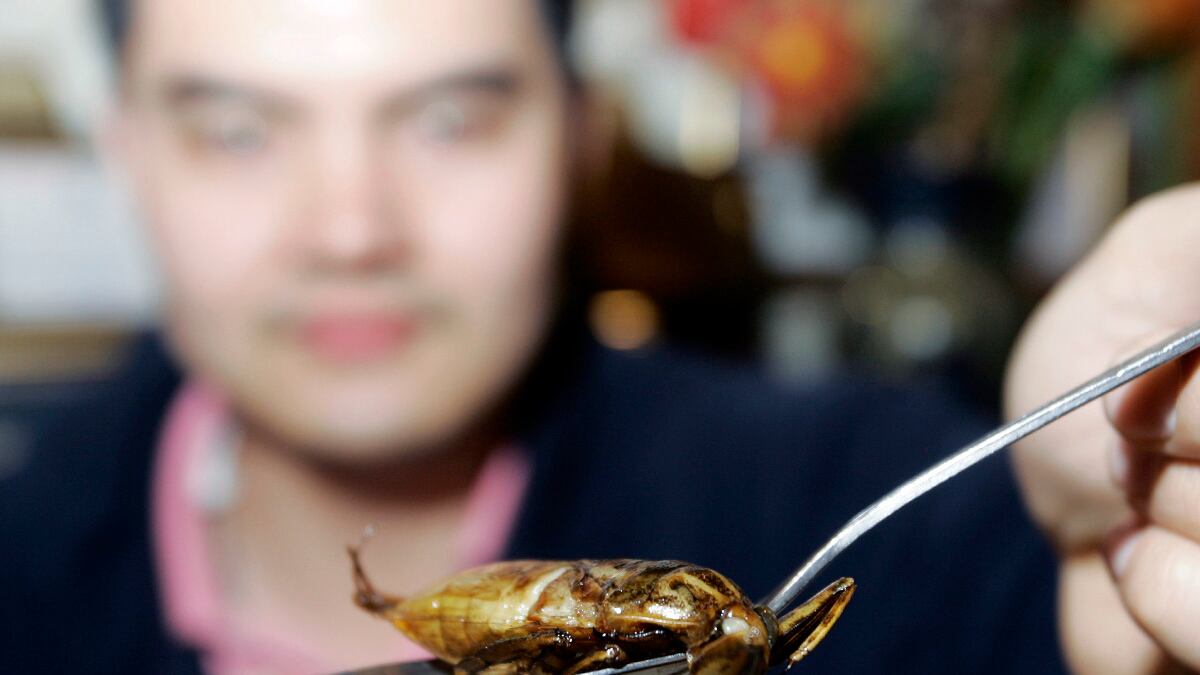It was, so far, the food story of the year. A revelation so revolting it hit every American town, small and large. A vegan activist website exposed the truth behind Starbucks and its food coloring. Or rather, the fact that it doesn’t use food coloring in its blended fruit drinks because it uses ground-up cochineal insects, which provide that rich pink color in your strawberry blended frappe.
An online campaign launched on Change.org urged Starbucks to yank the stuff. It wasn’t vegan, they said, and it technically isn’t kosher. So the Seattle-based coffee giant, wanting to avoid a PR disaster, obliged last week, and said it would return to tomato-based dyes. Starbucks’ President Cliff Burrows also apologized after he said the company “fell short of your expectations.” Those expectations, naturally, were not to turn everyday life into an unwitting episode of Fear Factor.
Yet here is where Americans have gotten it wrong. A majority of people on this planet eat bugs. And for good reason. They’re plentiful, they’re easy to raise and they provide a potent punch of protein. With three pairs of legs and cold blood, they’re about three-to-four times more efficient at converting food into muscle (that humans can then eat) than most livestock. They don’t carry food-borne illness like mad cow or salmonella—and those that do carry maladies like West Nile Virus are neutralized in a hot skillet, and then again during digestion. And many are packed with nutrients like zinc, iron, and calcium.
ADVERTISEMENT
Watching your physique? About 50 crickets contain only 120 calories. Body building? A handful of caterpillars packs 30 grams of protein. Termites and silk worms, for their part, have virtually no carbs. Those exoskeletons might be tough to pick out of your teeth, but cobble together those meatless parts and, voilà, extra fiber. In China, people eat fried bee larvae by the bucketful. Brazilians much on ants, either covered in chocolate or, again, fried. Australia’s aborigines have described moth larvae to be just as delightful as roasted almonds.

Of course, for vegans, who don’t eat animal products of any kind, insects are off limits. I called Eric Fortney, the editor of ThisDishIsVeg.com, the vegan group that initially broke the Starbucks news. His readers were mainly concerned they were misled about the drink’s supposed lack of animal products. Fortney recounted a story of one vegan woman who ordered strawberry drinks with cochineal extract almost every day, and is now fuming over being duped.
Yet for vegans who shun animal products as a protest against unnatural living and breeding conditions and foreign hormones in meat and dairy products—perhaps bugs could be worth making an exception? Insects don’t mind crowded living conditions; hell, they love them. Their brains aren’t wired to feel emotion, so studies have shown they hardly feel pain. And that hormone-infused feed on factory farms? Forget it. Much of what they like to eat is stuff we throw out anyway: wood chips, manure and trash. Whereas cows and chickens require hefty amounts of feed and water to grow, insects like crickets and beetles can get by with most of the stuff we’ve already gotten rid of. And to kill them, well, forget the slaughter house—just pop a bag of squirming crickets in the freezer. (Fortney, for his part, didn’t budge; “Vegans oppose eating animals at all,” he says. End of story).
Convinced already? Well it doesn’t actually matter because, guess what, even vegans are already eating them. In a New Yorker story last summer, writer Dana Goodyear revealed some unsettling facts. Every frozen or fresh package of spinach can contain up to 50 aphids, mites, or thrips before the FDA labels it contaminated. Peanut butter can have up to 30 insect fragments—that’s right, a wing, a leg, a decapitated ant head—per 100 grams. Most ice creams, yogurts, chapsticks, and candies already use cochineal insects for coloring. What’s more, every fruit or vegetable you eat sat in a field at one point. Being squeamish about bugs’ existence only makes us less healthy, requiring farmers to use increasingly more powerful pesticides to keep our veggies pristine.
Our aversion to these 6-legged creatures is, of course, mostly psychological. We think of insects as pests, as bottom feeders on the food chain. Plus, they look creepy. But plenty of what we eat has dubious ingredients that we simply accept. Ever had a hot dog? How about a Twinkie?
To be fair, it’s not all good news. You’d have to eat about 1,000 grasshoppers to get the equivalent protein in a 12-ounce steak. They’re not always cheap in this country, either. At Jose Andres’s restaurant Oyamel in Washington, D.C., an appetizer of a handful of grasshoppers will run you $5. At that rate, even the fanciest steak dinner would still be a bargain by comparison. Some bugs, like ants or yellow jackets, do carry small amounts of venom and should be avoided. Others carry some pathogens, but rarely anything that can’t be inoculated by cooking them thoroughly.
Not long ago, I met with a nutritionist friend of mine. “Should we be eating grasshoppers?” I asked her while she was mid-sentence talking about something else. She’s a woman who normally teaches kids how to grow carrots and stay away from junk food. So the question, at point blank, caught her off guard. “I don’t see why not,” she finally said. Then we talked about a future world in which protein would be hard to come by. And in which insects, wouldn’t be.
No matter how much Starbucks’s management wants to use cheap, ground cochineal bugs, the customers will always decide the fate of Starbucks’ products. That’s business. And yes, it’s reasonable to be perturbed about things in your food that you didn’t expect or to realize that all this time you actually haven’t been keeping kosher. But squeamishness over insects? In the race for food access and sustainability, we’d better get used to them.





